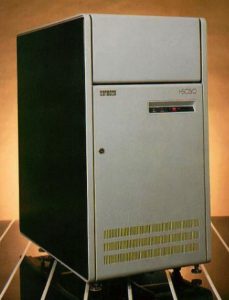History (1983): First NAS Commercialized by DEC
Then by Auspex in 1989
This is a Press Release edited by StorageNewsletter.com on May 10, 2018 at 2:08 pmThis article comes from the Computer History Museum.
1983: Networked Storage Systems commercialized
VAXcluster allows sharing across a pool of block-level storage
DEC HSC50 Mass Storage Server brochure (1983)

(Digital Equipment Corporation)
Storage systems comprise multiple storage devices, such as HDDs and tape drives, with layers of hardware and software to create a reliable, high-performance networked unit. Early systems were connected to a single computer through dedicated interface devices.
The concept of dynamically sharing stored data among independent networked computers emerged in the 1970s with systems such as the Digital Equipment Corporation DECnet suite of protocols that supported file sharing (serving) over serial, LAN, WAN, satellite links, etc. DEC’s VAXcluster, announced in May 1983, allowed up to 15 VAX computers each running its own copy of VMS, to share files via a distributed lock manager, across a pool of storage devices (disks, tapes, etc.) controlled by multiple Hierarchical Storage Controllers (HSCs). The widespread adoption of the VAXcluster made the HSC one of DEC’s most successful products.
NAS from Auspex in 1989, employed a dedicated file-level storage server running Sun’s distributed Network File System (NFS) for Unix over standard Ethernet connections.
In 1993, NetApp introduced a lower-cost, more scalable file server appliance that included SMB/CIFS (Server Message Block/Common Internet File System) for Windows. The NetApp system eventually dominated the NAS market and also appeared in low-cost consumer backup applications.
SANs from Brocade in 1997 with switched FC networks provided pools of block-based storage to clients and servers having their own file systems. An overlying SAN Filesystem permitted sharing of copies of files stored on common storage media among multiple servers with different OSs.
As NAS and SAN have co-evolved at ever-increasing speed, they have essentially eliminated distance as a constraint to network system performance.













 Subscribe to our free daily newsletter
Subscribe to our free daily newsletter

